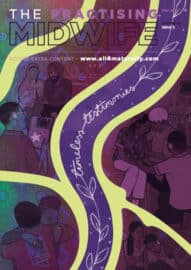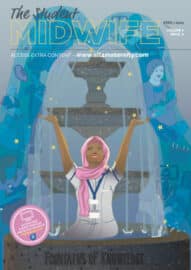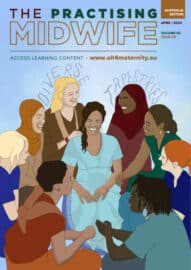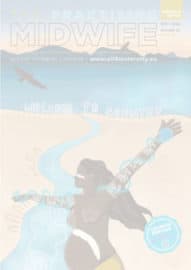by Laura Godfrey-Isaacs and Helen Knowles

The Birth Rites Collection of contemporary art about childbirth – opening at King’s College London, Guy’s Campus, 25th January 2018 (open to the public by appointment)
In January 2018 The Birth Rites collection, the first and only collection of contemporary artwork dedicated to the subject of childbirth, curated by artist Helen Knowles, relocated from The University of Salford Midwifery School, Manchester to the Department of Midwifery at King’s College London, for a period of three years. This is a really exciting move, providing access to the works for the students, academics and public in London, and will support the Art and Humanities module already being taught as an intrinsic part of the midwifery degree at King’s. It is also hoped that interdisciplinary research around the representation of birth will be generated by the collection’s presence – and this is already being hatched through a collaboration between myself Laura Godfrey-Isaacs (artist and midwife), Dr Elsa Montgomery (Head of Midwifery at King’s), Helen Knowles (artist and curator of the Birth Rites Collection) and artist and academic Hermione Wiltshire (Senior Tutor at the Royal College of Art, London).
The collection
The collection currently comprises 70 works of photography, sculpture, painting, wallpaper, drawing, new media, documentary and experimental film. The aim of the collection is to encourage debate and increase awareness around childbirth practice, and to explore the use of contemporary art to consider the social, political and cultural implications of birth.
Birth Rites seeks to explore how, traditionally, the visual representation of birth has been a taboo subject to show in the public domain. This has changed exponentially in recent years, with the advent of online video platforms and TV series on the subject. However, it is the presentation of these artworks in teaching spaces, that challenges and shifts preconceived perspectives on birth, and opens up new ways of looking at the subject for the midwifery, medical and other students at King’s as well as the wider public. The artworks consider subjects including: birth technologies like IVF and caesarean section; conception; abortion and miscarriage; pregnancy; normal birth; unassisted birth; stillbirth; the roles of the midwife and medic; postnatal depression; and myths and stories on birth. The chance to pose questions on the subject through a physical artwork which decorates the walls and corridors of the college, permeating visitors’, students’ and academics’ consciousness, will enable a more visceral and intuitive engagement with birth.
A challenging subject
The potency of contemporary art to challenge and shift current paradigms by exposing and representing the deeply unpopular, uncommercial and precarious subject of birth and care work, by using the market tool of an art collection, lies at the heart of this project. Additionally, the collection’s potential to rehabilitate the status of birth as a valid subject to explore within the context of contemporary art, is equally important. Furthermore, the collection’s presence at King’s, and the wider interdisciplinary research it will engender provides an opportunity to profile the potential for learning about birth through the use of art and other cultural reference points – something that has a strong tradition in medical education, but is lacking in most midwifery contexts, and which provides a rich source for advancing midwifery students’ understanding, discovery and knowledge about women’s experiences of birth, social and political issues of maternity, mothering and the representation of women’s bodies in society.
Information about the Birth Rites Collection at King’s College London: https://www.kcl.ac.uk/nursing/newsevents/news/2017/The-Birth-Rites-Collection.aspx
Birth Rites website: http://www.birthritescollection.org.uk
A sample of some of the artworks in the Collection
Ana Casas Broda

Kinderwunsch by Ana Casas Broda 2014, from the book Kinderwunsch. Printed by La Fabrica, Spain 2014. 28 pieces, 70 x 90cm, inkjet print on cotton paper mounted on Alu-Dibond, 2006-2012
Kinderwunsch is a book and an exhibition in which texts and photos construct a narrative that approaches maternity as a setting of complex interactions, where the artist’s children’s identity is created and her profound transformations as a mother are explored. Developed over seven years, the photographs – part of Kinderwunsch – show the artist and her children carrying out actions in different scenarios. Photography becomes a vital form of intervention in a reality, which holds the tension between the recreated action and spontaneity, where reflection and intuition converge. It also acts as a space that reveals the fundamental connections in relationships. It is a search for apparitions of a reality that is not always visible. In Kinderwunsch, Ana Casas Broda considers motherhood as an identity that is not fixed and is grounded in daily acts and sensations. The body and the home are fundamental axes of this project.
Billie Bond

A link with the past, 2011, diptych sculpture on wooden plinth
A link with the past explores maternity and motherhood, themes expressed through sculpture by humans since the beginning of civilisation, but a subject that today seems to have been pushed aside by education, career aspirations and financial constraints. This work is the result of questioning today’s decline of young planned motherhood and the rejection of breastfeeding. It uses the notion of ancient artefacts as a vehicle to consider the decay of maternity and motherhood. Princess Tootee sits quietly like a deity worthy of worship, a forgotten civilisation. Synthesising a digital technology, such as the QR code, within the traditional craft of mosaics, brings this work into the contemporary world. Deciphering the QR codes with a mobile phone invites the viewer to be part of a creative process and it’s a step forward in changing attitudes towards motherhood.
Judy Chicago

The crowning, 1982 and The creation of the world, 1985, both from The Birth Project.
The crowning, drawing, painting and colour specification by Judy Chicago. Batik from Chicago’s drawing by Dianne Barber (San Francisco). Embroidery and quilting by Gwen Glesman (Washington, DC). The creation of the world, painting on mesh canvas by Judy Chicago with Lynda Healy. Needlepoint 5c over Chicago’s painting by Susan Hill, Julian NC.
Judy Chicago began working on ‘The Birth Project’ in 1980, collaborating with more than 150 needle workers during the process. By the time it was finished, it had taken five years.
‘I have approached the subject of birth with awe, terror, and fascination and have tried to present different aspects of this universal experience: the mythical, the celebratory, and the painful,’ writes Chicago in the book, Judy Chicago. The Birth Project.
Dominika Dzikowska

Warm wet velvet, 2009-2013, Lambda Print
Warm wet velvet focuses on the experience of childbirth, as few other human experiences can compare with its intensity. Extreme emotions of fear, excitement, tenderness and anger are mixed together and accompanied by a strange, almost narcotic trance. Dominika Dzikowska is interested in this complex process seen from the perspective of the unsung hero – the woman who gives birth. This project captures the ambiguity of birth, with its sexual, sensual and spiritual aspects. The title refers to the newborn. Iwona, a young mother who took part in the project, said of her experience: “The midwife told me that I could touch the head. It felt like warm, wet velvet.”
Liv Pennington

Private view, 2006, digital C Type on aluminium, 80 x 70cm
Private view is a composite print of 40 different women’s pregnancy tests. A photograph of each test has been combined with text written by the women as they waited to participate in the performance. Each is unique, like a fingerprint, presenting different patterns and colours.
As a performance, Private view took place in London (2006), Poitiers and Oslo. On the night of Private view, every woman who went to use the toilet was asked if she would want to take a pregnancy test. The results were relayed live above the bar. The indicating windows of the pregnancy test were the only parts to be projected, initially appearing abstract. There wasn’t any sound and the tests were broadcast anonymously. If the women wanted to know the result, they could ask at the bar.
Suzanne Holtom

Contact, 2008, oil on linen, 185 x 190cm
Suzanne Holtom spent five weeks working closely with Sarah Vause, obstetrician at St Mary’s Hospital, Manchester. Suzanne developed close relationships with some of the women she met and this became an integral part of her work. Contact is medically coloured, where the application of the paint is out of control, dripping and lactating, which contrasts sharply with the hard-edged technology that surrounds Ildiko, the woman who is depicted engaged in the precious time she has with her baby. It is not only the awkward yet absorbed moment of mother and baby that is represented, but also the contact between the monitor and baby. Suzanne has come to focus on the site where technology and the body meet: a site which, in the process of birth, can be seen as a place of dependency and conflict, raising issues of care, control, displacement and surveillance.
Tabitha Moses

Islands of blood and longing, 2010, blood on Fabriano paper
Islands of blood and longing was made in the weeks following the loss of a much-wanted pregnancy. Constructing this map was, for Moses, a way to salvage grace and meaning from an incomprehensible occurrence. The stains of lost blood became islands that, in turn, formed a chart to help her find her way. The phases of the moon counted the days while the compass brought order and direction.
Valerie Schmidt

Formations / Seeds, 2013, light jet c-type print, 40 x 50cm
The work Formations / Seeds presents a series of delicate formations, which are taken out of context and have been rearranged. The ordinary objects are being transformed into fragile, momentary allegories. The intention of these figurations is to charge them with emotional meaning and to depict borders between stability and collapse. The image depicts seeds creeping up a plate, which may also be an abstract presentation of a female egg or a womb.
Hermione Wiltshire

Therese in ecstatic childbirth, 2008, digital print, 50 x 65cm
Hermione Wiltshire spent time observing the preparation of expectant parents at birth workshops given by the President of the NCT, Gail Werkmeister. Here Hermione witnessed the anxieties and hopes of parents-to-be. She became very aware of the prevalence of negative images of birth. She says, “My work often reflects my interest in images that are politically charged. I am particularly interested in the cultural anxiety around images of crowning. [This] moment…is seen as shocking, stimulating the same response as a pornographic image.” Such images of crowning were not used in Gail’s workshops because she believed their impact was distressing. At Matrix, a Birth Rites forum, Gail asked the audience, “Should I traumatise them?” Instances like these have been occurring since the beginning of the project, where those involved reassess how they work and why. In response to this research Hermione chose to present what she believes is the answer to Gail’s dilemma; she presents Ina May Gaskin’s image of a woman crowning in ecstatic childbirth.







